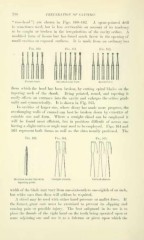Page 218 - My FlipBook
P. 218
G
21 PREPARATION OF CAVITIES.
^'rose-head") are shown in Figs. 160-162. A spear-pointcd drill
is sometimes used, but is less serviceable on account of its tendency
to be caught or broken in the irregularities of the cavity orifice. A
modified form of fissure bur has found much favor in the opening of
small cavities on exposed surfaces. It is made from an ordinarv bur
Fig. IGO. V\r,. Kil. Vu:. liVl.
Fissure burs. luverted-coae burs. Round bur.'
from which the head has been broken, by cutting spiral blades on the
tapering neck of the shank. Being pointed, round, and tapering it
easily eiFects an entrance into the cavity and enlarges the orifice grad-
ually and symmetrically. It is shown in Fig. 163.
In cavities of larger size, where decay has made more progress, the
overhanging walls of enamel can best be broken down by chisels of
suitable size and form. Where a straight chisel can be employed it
will be found most efficient, but in positions difficult of access one
having a slight curve or angle may need to be employed. Figs. 164 and
165 represent both forms as well as the sizes usually preferred. The
Fig. 163. Fig. 164. Fig. 165.
Modified fissure bur with Straiglit chisels. Curved chisels.
tapering point.
width of the blade may vary from one-sixteenth to one-eighth of an inch,
but wider ones than these will seldom be required.
A chisel may be used with either hand pressure or mallet force. If
the former, great care must be exercised to prevent its slipping and
causing pain or possible injury. The best safeguard in its use is to
place the thumb of the right hand on the tooth being operated upon or
some adjoining one and use it as a fulcrum or pivot upon which the
21 PREPARATION OF CAVITIES.
^'rose-head") are shown in Figs. 160-162. A spear-pointcd drill
is sometimes used, but is less serviceable on account of its tendency
to be caught or broken in the irregularities of the cavity orifice. A
modified form of fissure bur has found much favor in the opening of
small cavities on exposed surfaces. It is made from an ordinarv bur
Fig. IGO. V\r,. Kil. Vu:. liVl.
Fissure burs. luverted-coae burs. Round bur.'
from which the head has been broken, by cutting spiral blades on the
tapering neck of the shank. Being pointed, round, and tapering it
easily eiFects an entrance into the cavity and enlarges the orifice grad-
ually and symmetrically. It is shown in Fig. 163.
In cavities of larger size, where decay has made more progress, the
overhanging walls of enamel can best be broken down by chisels of
suitable size and form. Where a straight chisel can be employed it
will be found most efficient, but in positions difficult of access one
having a slight curve or angle may need to be employed. Figs. 164 and
165 represent both forms as well as the sizes usually preferred. The
Fig. 163. Fig. 164. Fig. 165.
Modified fissure bur with Straiglit chisels. Curved chisels.
tapering point.
width of the blade may vary from one-sixteenth to one-eighth of an inch,
but wider ones than these will seldom be required.
A chisel may be used with either hand pressure or mallet force. If
the former, great care must be exercised to prevent its slipping and
causing pain or possible injury. The best safeguard in its use is to
place the thumb of the right hand on the tooth being operated upon or
some adjoining one and use it as a fulcrum or pivot upon which the


